#macrospondylus
Explore tagged Tumblr posts
Text
Some recent croc encounter
Ive been on „vacation“ last week which honestly was mostly taking a friend to various zoos and aquariums across Austria, but that did lead me to getting to see a fair share of crocs in a fairly short time span.
Right on day 2 it was another meeting with Leila, the female Mecistops that resides in Viennas aquarium. This is now my second time seeing her and shes still a beauty.


A day later we visited the House of Nature museum in Salzburg, which had just opened its new reptile halls. As part of the makeover, which focused a lot on cohabitation and larger, natural exhibits, the museum had go part with its American Alligator that had simply become too large. While I did subsequently miss out on seeing it again after like two decades, they did get a new crocodilian in its place, a much more manageable dwarf crocodile.


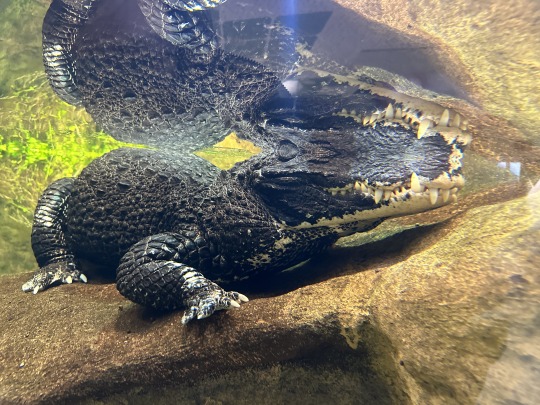
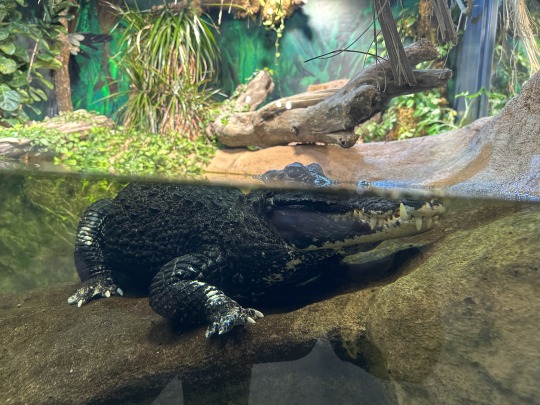
The first room furthermore featured two skulls, one of a crocodile and one of a gharial, nicely highlighting the diversity of modern crocodilians. Downstairs in the dinosaur hall they also displayed the skeleton of Macrospondylus, but given how common fossils of that animal are I wont dwell on it beyond saying that its size was rather impressive.


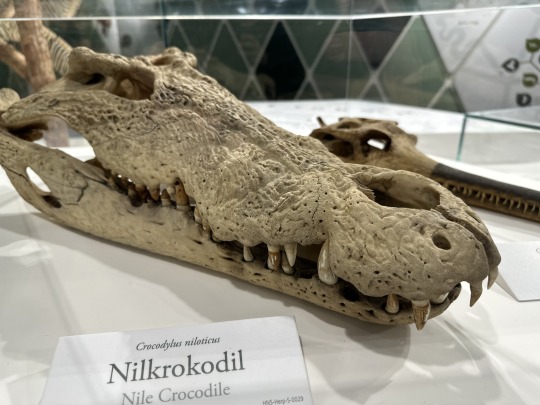
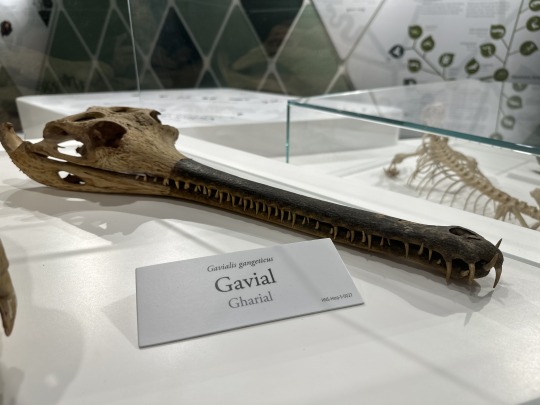

Skipping ahead a few days brought us back to Salzburg, this time to the zoo just outside the city. While featuring nothing too large, the jaguar house still showcased a crocodilian, specifically a dwarf caiman. Alas, despite stopping by around 5 times, it was less cooperative in terms of posing than my previous two encounters. Still, the enclosure was quite nice and featured some cohabitation with basilisk lizards and bats (that I sadly couldn't find).




The last zoo of the week was in Schmieding in Upper Austria. Now when I was a kid they had a nile and, in the adjacent aquarium, some spectacled caimans. However nowadays they scaled down, having moved the caimans into the old nile crocodile pool in the rainforest house. Funny enough they were the only ones on the trip to have been on land, tho they were looking a little rough if truth be told.

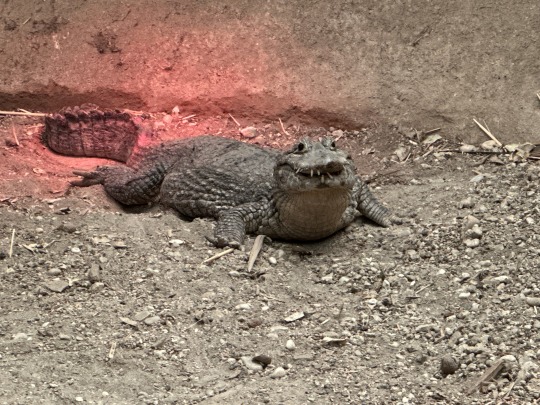
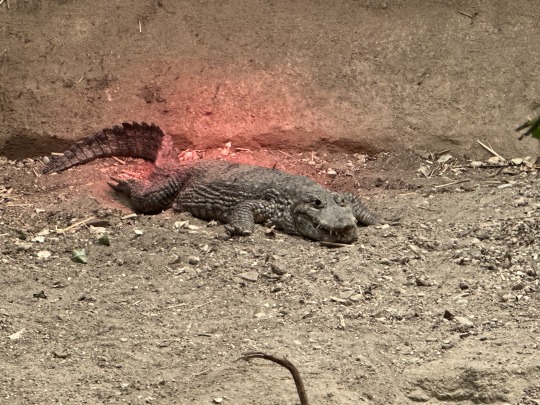
And that was it in broad strokes. Some were certainly more exciting than others, Leila remains a stand out and the new Salzburg Osteolaemus was nice to see. Obviously the trips featured a lot of other interesting stuff from 9 meter sturgeon models in Bratislava to free roaming ringtail lemurs and stuffed rhinogrades in Salzburg and plenty more, but alas all four species encountered were animals I have seen before, so I don't get to cross anything off my list this time around.
#haus des meeres#vienna#mecistops cataphractus#slender-snouted crocodile#haus der natur#museum#salzburg#osteolaemus#dwarf crocodile#gharial#nile crocodile#macrospondylus#dwarf caiman#zoo salzburg#paleosuchus#paleosuchus trigonatus#zoo schmieding#caiman#spectacled caiman#crocodiles#croc#pseudosuchia#crocodilia
65 notes
·
View notes
Text

Day 11: Macrospondylus bollensis
#paleoart#art#dinosaur#prehistoric#paleontology#digitalart#traditionalart#Archosaur#Archovember2023#Archovember#Dinovember#Dinovember2023#DrawDinovember#DrawDinovember2023#Macrospondylus#Macrospondylusbollensis#Crocodylomorpha
146 notes
·
View notes
Text
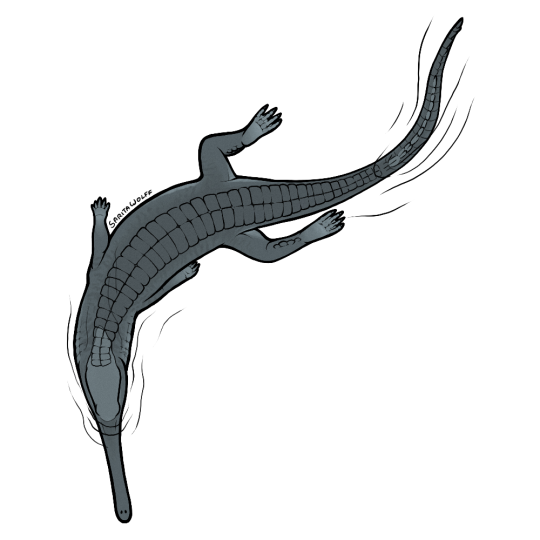
#Archovember Day 11 - Macrospondylus bollensis
The Thalattosuchians were a clade of marine pseudosuchians commonly called “marine crocodiles” or “sea crocodiles”. They were seperated into two groups, the Teleosauroids and the Metriorhynchoids. The metriorhynchoids seemed to be adapted for spending all their time in the water: they had smooth, scale-less skin, tail flukes, and even flippers. Meanwhile, teleosauroids held onto their crocodyliform nature, retaining their osteoderms and probably heading onto land when needed. They inhabited a wide range of habitats: from semi-marine coasts and estuaries, to open-ocean, to freshwater. The Early Jurassic Macrospondylus bollensis was one of these teleosauroids.
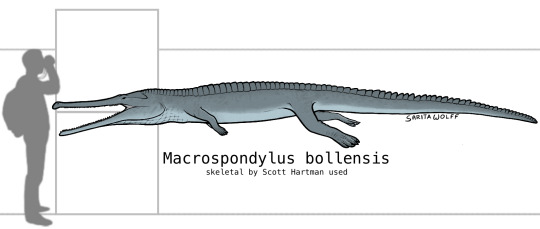
Macrospondylus bollensis, long known as “Steneosaurus bollensis” (Steneosaurus being a wastebasket taxon for thalattosuchians) finally had its genus revived in 2020. At 5.5 m (18 ft), it was the largest known Early Jurassic crocodylomorph. Like many other teleosauroids, it had a long, tapering snout, similar to its modern equivalents the gavialids. This snout would have allowed it to quickly maneuver through the water with little resistance, snapping up fish. Oddly enough, like Megalosaurus, Macrospondylus is also represented in the Crystal Palace gardens (though they are simply labeled as Teleosaurus). Modeled after gharials and based on much better preserved fossils than Megalosaurus, the teleosaur statues actually hold up pretty well, other than using a more crocodilian scute pattern.
Macrospondylus bollensis fossils have been found in Germany, the UK, and Luxembourg. It lived in the newly forming Tethys Sea, which was warm and shallow at the time, dotted with small tropical islands where Macrospondylus would have likely emerged to bask in the sun. This area is known for its fossilized crinoids, cephalopods, bivalves, crustaceans, ichthyosaurs, sharks, bony fish, and more, often exquisitely preserved “frozen in time” due to sudden events and nigh perfect fossilization factors. There was an abundance of fish here for Macrospondylus to feast upon, including chimaeras like Acanthorhina, the armoured Dapedium, the long-bodied Euthynotus, pups of the shark-like Hybodus, the herring-like Leptolepis, and many more. It would have lived alongside a variety of icthyosaurs, small plesiosaurs, other teleosauroids such as Mystriosaurus, Pelagosaurus, and Platysuchus, pterosaurs such as Campylognathoides and Dorygnathus, and come across sauropods such as Ohmdenosaurus wandering the shorelines. But Macrospondylus was not the biggest “fish” in the sea, and if it ventured into the open ocean it could have come across the 8–10 metre (26–33 ft) long icthyosaur Temnodontosaurus, the apex predator of the Early Jurassic Tethys Sea (which is also on display at the Crystal Palace!)
#my art#SaritaDrawsPalaeo#Macrospondylus#Macrospondylus bollensis#Teleosauroid#Teleosaur#Thalattosuchians#Crocodyliforms#pseudosuchians#archosaurs#archosauromorphs#reptiles#Archovember#Archovember2023
10 notes
·
View notes
Text
Una nuova ricerca fa luce sugli enigmatici parenti dei coccodrilli del giurassico
Una madre di Macrospondylus bollensis tiene d’occhio i suoi piccoli. In uno studio pubblicato sulla rivista Papers in Palaeontology, i paleontologi del Museo Statale di Storia Naturale di Stoccarda hanno analizzato i tassi di crescita di Macrospondylus bollensis, una specie di coccodrillo teleosauroide del Giurassico europeo. Il Macrospondylus bollensis visse nell’attuale Europa durante il…

View On WordPress
0 notes
Text
Croc Paleontology Recap Febuary 2025
January passed so fast probably cause its the shortest month but we still got a handfull of papers out of it. So lets get right into it.
The function of the armor of Stagonolepis
Getting us started in the Triassic is a paper on the osteoderms of the aetosaur Stagonolepis: "The histology and function of the dermal armour of the aetosaur Stagonolepis olenkae Sulej, 2010 (Archosauria, Pseudosuchia) from Krasiejów (SW Poland)". Now as you probably figured from the handfull of times I've talked about aetosaurs on here, their osteoderm armor is very characteristic, very important in telling them apart and VERY extensive.
The results of this study are interesting. For starters, although osteoderms frequently serve a function in thermoregulation in modern crocs and even temnospondyls, this does not appear to have been the case for Stagonolepis. Now superficially, aetosaur osteoderms do show the same pitted surface as modern croc armor, which is caused by the elements absorbing bone and depositing it elsewhere throughout growth, something that reduces mass while maintaining stability and also increases surface area. However, Stagonolepis osteoderms are not vascularized like those of modern crocs, lacking the densely packed blood vessels that help absorb heat. The external surface of the osteoderms also doesn't show signs of thick sharpeys fibres, which are generally used to anchor the osteoderm in the soft tissue. What this means is that the osteoderms were not deeply embedded in skin (as has been suggested for some notosuchians) but rather were covered in keratin like those of modern crocs. But if not for thermoregulation, then what are the osteoderms for. Well on the one hand, obviously they work as armor. Their structure makes them robust yet leight weight and they are firmly embedded through sharpeys fibres present on the lower cortex of the osteoderms (tho its highlighted that they aren't as densely packed as in ankylosaurs). The keels that mark the osteoderms further prove to be quite usefull when it comes to reducing stress from a vertical attack. If you really want an additional reason for the armor, the authors offer the suggestion of being an adaptation to prevent water loss. Finally, histology shows that the osteoderms do not feature lines of arrested growth (basically signs for poor growth throughout the animals life), which suggests that the environment inhabited by Stagonolepis was quite moderate and did not have strong seasons that might influence the animals growth throughout its life.
Bottom: A diagram of Stagonolepis is sideview, showing the various types of osteoderms covering its body. Reconstruction by S. Górnicki

Growth strategy in Trialestes and its implications
Up next something not too different from a study we had in January. Last time we had a study on the growth of a peirosaurid notosuchian, this time "A fast start: Evidence of rapid growth in Trialestes romeri, an early Crocodylomorpha from the Upper Triassic continental beds of Argentina based on osteohistological analyses" brings us something similar except for the "sphenosuchian" Trialestes (more on that group later).
So what did we learn? Well for starters, neither of the examined specimens (which included the holotype) were mature, both in terms of sexual maturity and skeletal growth. What is weird is that morphology (specifically bone fusion in the vertebra) indicates the opposite to what has been concluded based on bone microstructure, which may suggest that in Trialestes either reached sexual maturity at a delayed rate of that histology and sexual maturity do not correlate all that much. Anyhow, based on crosssections of the bones, they are estimated at a minimum of two years and one year of age at the time of their deaths. Histology also shows that Trialestes appears to have grown quite rapidly. Curiously a previous study estimated a third specimen to have been one year old, eventhough this new study recovered the same age for a specimen only half that size. This seems to suggest that age and growth do not really correlate for some unknown reason, with possible explanations including differences between sexes or simply differing environmental conditions. Looking at the results at a grander scale, similar growth rates have previously been calculated for other nimble crocodylomorphs such as Terrestrisuchus and Saltoposchus, with the latter growing even faster than Trialestes. Of course when you get into more derived members of Crocodylomorpha strategies start to change, for example the slightly more derived Hesperosuchus was growing at a slower speed than Trialestes and if you recall January we know that Notosuchians can differ even within a genus (see Araripesuchus). Modern crocs appear to generally grow slower overall in their ontogeny, tho in some like the broad-snouted caiman environmental conditions seem to play quite the rolle. Nevertheless, the paper concludes that faster growth rates appear to be more widespread in early crocodylomorphs and may have been the ancestral condition.
Below: Reconstruction of the head of Trialestes by Joschua Knüppe (there is really not much art of this guy out there)

Now for two papers that are very relevant to my efforts on Wikipedia, namely two studies on the European alligatoroid Diplocynodon.
Growth strategy of Diplocynodon hantoniensis
First of all, sorta the same thing we just had for Trialestes but applied to Diplocynodon hantoniensis, a species from the Eocene of southern Britain (and actually one of the first Diplocynodon species discovered). The greater goal of "Evolution of growth strategy in alligators and caimans informed by osteohistology of the late Eocene early-diverging alligatoroid crocodylian Diplocynodon hantoniensis", as you might guess from the title, is actually to use Diplocynodon in order to figure out how growth strategies evolved in the two modern groups of alligatoroids, gators and caimans, who share similar strategies despite having been separated from another since before the extinction of the dinosaurs.
With 9 studied upper leg bones, the sample used in the study ranged from immature specimens to adults, which in the case of D. hantoniensis might reach lenghts of 1.2–3.4 meters. The growth strategy of Diplocynodon is recovered as both being determinate (meaning that they stop growing at a certain point) and seasonally controlled (which feels self-explanatory), both also seen in modern alligatoroids. Now assuming that the growth marks accurately reflect yearly intervals (which may not necessarily be the case), then the studied individuals ranged between 5 and 26 years old at the least. Skeletal maturity seems to have been reached in a similar range as modern alligatoroids (gators reaching maximum size between 30 and 40 and caimans between 12 and 18). As with Trialestes earlier, there are some individuals that show signs of being fully grown, yet are less than half the size of other individuals, possibly indicating sexual dimorphism (female gators stop growing earlier and at a lower size than males) or environmental conditions that affected growth (though there is doubt cast over this latter interpretation). The study concludes that, based on Diplocynodon hantoniensis, alligatoroids are simply relatively conservative in their growth strategy and what we see in gators and caimans is likely their ancestral strategy, rather than having been developed independently.
Below: A photo of the skull of Diplocynodon hantoniensis (taken by John Cummings), not actually relevant to the study but I mean it shows what this thing looked like.

The sense of smell and EQ of Diplocynodon tormis
Moving away from the Eocene of the UK and to the Eocene of Spain, we got a different species of Diplocynodon as the main subject of "New data on the inner skull cavities of Diplocynodon tormis (Crocodylia, Diplocynodontinae) from the Duero Basin (Iberian Peninsula, Spain)". Specifically, the study deals with the description of and what we can learn from a CT-scan that gives us insights into the forebrain, olfactory bulbs, nasal cavity, air sinuses, etc..
Overall the shape of the brain matches the idea that Diplocynodon is an early alligatoroid, including some distinctive features of this clade and some traits that are basal to crocodilians. Like modern alligators, Diplocynodon tormis seems to have had a good sense of smell, though not as keen as that of crocodyloids. The holotype specimen falls within the upper values in terms of olfactory acuity among alligatoroids, but still clearly outside of the range exhibited by crocodyloids, while another studied specimen performed a lot poorer (though its also not as well preserved). As for cognitive abilities, the study also calcuated the Reptilian EQ of D. tormis. The authors note that the EQ of Diplocynodon tormis appears below the average of other medium-sized crocodilians and instead comes closer to the EQ of large forms. Tho it is also noted that damage to the specimen might have affected the results.
Left: A 3D model of the holotype skull of Diplocynodon tormis Right: A 3D model of that same skull but highlighting the various internal structures such as the brain, nasal cavity, nerves, etc..


A history, redescription and the biology of the teleosaur Macrospondylus
Ah Macrospondylus bollensis, once known under the name Steneosaurus (like every other teleosauroid lets be honest), perhaps one of the most well known members of this group given its extensive fossil record from the Posidonia Shale in Germany. Despite this, and also like many other teleosauroids, its history is confusing, long and just a whole can of worms. One dealt with in "A re-description of the teleosauroid Macrospondylus bollensis (Jaeger, 1828) from the Posidonienschiefer Formation of Germany".
To give you the abridged version, the holotype of Macrospondylus bollensis was found all the way back in 1755 (meaning it was discovered so long ago even Napoleon wasn't born yet) and quickly recognized as some sort of crocodile relative. It was named Crocodilus Bollensis in 1828, described in the 1830s and given the genus name Macrospondylus in 1831 (and then again by a different author in 1837, seemingly independent of the previous study).
Being this old, of course the fate of Macrospondylus would be shaped by historical events, specifically the German revolutions of 1848–1849, when a fire set by revolutionaries in Dresden grew out of control and spread to the collection, damaging but thankfully not destroying the fossil. Chaos ensued unrelated to that as various researchers proceeded to lump Macrospondylus into either Teleosaurus, Mystriosaurus or even Geosaurus before circling back to Crocodilus, eventually settling on Steneosaurus in the 1960s. Scientists did eventually grow wise to Steneosaurus being an overlumped wastebasket of a taxon, but this was not fixed until 2020 when this gordian knot was hacked to pieces once more, resulting in the revival of Macrospondylus.
Keeping all this confusion in mind, recent work including this paper still finds that Macrospondylus is actually the most abundant Toarcian teleosaur and especially common in Germany (no doubt thanks to the Posidonia Shale, this doesn't necessarily reflect how things were at the time). In terms of ecology, Macrospondylus may have been a long-snouted generalist, being able to consume a much wider selection of and overall bigger prey than some of its rarer relatives. Size might also have been a factor, since large Macrospondylus reach up to 5 meters in length and would therefore have access to more robust and larger prey. Its wide distribution might also suggest that it was less picky than other teleosauroids about where it lived and though previously suggested to have been more marine, this new study seems to favor the idea that it was still fairly amphibious throughout its life. This is interesting given that the Posidonia Shale, where so many specimen are known from, is a pelagic off-shore open ocean environment, with the potentially more terrestrial Platysuchus and the shallow water Plagiophthalmosuchus being much rarer. Of course, there is always the possibility that this idea of Macrospondylus being super common is skewed simply by the preservation and the excavation at Holzmaden, which as said before might not reflect the state of the entire species population.
Left: A fossil of Macrospondylus next to Dr. Michela Johnson, photo by Meike Rech Right: Thalattosuchians from Tübingen by Pascal Abel, the two skeletons on the left wall and the bottom slab on the right all represent Macrospondylus Bottom: Macrospondylus photographed by Sven Sachs



The metabolism of Notosuchians
Back to something less constrained to any specific taxon, we got "Revisiting the aerobic capacity of Notosuchia (Crocodyliformes, Mesoeucrocodylia)",a paper on notosuchian metabolism, which is one of those things that might surprise people unfamiliar with them.
Of course Notosuchia is the great post-Triassic terrestrial radiation of the crocodile-lineage, bringing forth a great diversity of land-dwelling froms from small omniv, ores, bulky herbivores and even lanky carnivores. Despite this, it might come as a surprise that they were in fact not "warm blooded". This is again reinforced by this months paper by Sena and colleagues, who recover that their mass-independent maximal metabolic rates lie somewhere between modern crocs and monitor lizards (which again fits with previous studies on the matter). This means that fitting with their anatomy and lifestyle, they were more active than modern crocs and able to sustain more vigorous activity. Being ecto-thermic, they were still dependent on outside temperatures to heat them up before they were able to really take things to their fullest. Consequently it has also been hypothesized quite a bit that to cool down, they might have entered burrows later in the day.
Left: Two Baurusuchus are shown hunting a small Caipirasuchus, with all individuals shown as being fast, agile and terrestrial. Artwork by Deverson da Silva Right: Armadillosuchus emerging from its burrow under a tree stump with a herd of sauropods in the back. Artwork by Julia d'Oliviera

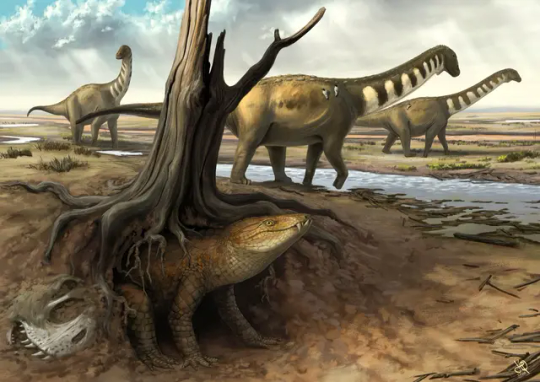
Now, for what I'm guessing all five of you that made it this far have been waiting for. The newly named crocs....which I didn't have time to make dedicated posts for. Look shit sucks alright, weekends have been really brief this month and I feel very tired.
Pattisaura: A new sphenosuchian from Texas
Getting us started on Pattisaura, a new genus of "sphenosuchian" (I told you I'd come back to them) from the Late Triassic Cooper Canyon Formation of Texas. Described in "A new crocodylomorph (Pseudosuchia, Crocodylomorpha) from the Upper Triassic of Texas and its phylogenetic relationships", this little guy generally represents what one might see as a quintessential sphenosuchian. A somewhat body pointed skull with large eyes, terrestrial habits, long and slender legs, a far cry from what we tend to associate with crocodylomorpha today.
The name Pattisaura was coined in honor of Mrs. Patricia Kirkpatrick, who's family has let paleontologist look for fossils on their farm (gee I wonder why that name sounds familiar) and the species name gracilis derives from....I mean do I even need to say it?
Unsurprisingly, the phylogenetic analysis of this study shows that Sphenosuchia is paraphyletic and doesn't actually form a single clade, instead simply representing a series of consecutively branching early crocodylomorphs. What can be said is that Pattisaura seems to clade with Redondavenator.
While perhaps unassuming in size or ferocity, little Pattisaura is nonetheless an interesting addition to the pseudosuchian fauna of the Cooper Canyon Formation, which has previously yielded the remains of the phytosaur Machaeroprosopus, various aetosaurs including Desmatosuchus, Aetosaurus, Typothorax and Paratypothorax, poposauroids like Shuvosaurus and the iconic Postosuchus alongside many other Triassic classics such as drepanosaurs, silesaurids, lagerpetids, coelophysoids and more.
Left: The skull of Pattisaura photographed by Aaron dp Right: The skull in top, bottom and sideview, reconstructed to account for taphonomic distortion and damage to the material


Thilastikosuchus: Brazil's oldest notosuchian
And the final one for this month is Thilastikosuchus scutorectangularis (mammal crocodile with rectangular scutes) described in "Anatomical description and systematics of a new notosuchian (Mesoeucrocodylia; Crocodyliformes) from the Quiricó Formation, Lower Cretaceous, Sanfranciscana Basin, Brazil". This little guy, and I mean little as it is based on a juvenile specimen, was recovered from the Early Cretaceous Quiricó Formation of Brazil and represents a new member of the obscure family Candidodontidae.
To give a brief description, Thilastikosuchus was a small, slender-limbed animal, although admittedly we only have a juvenile to go off from. Its teeth are prominently heterodont, meaning that rather than having jaws filled with relatively similar conical teeth its dentition was a lot more diverse, specifically consisting of subconical incisiforms and molariforms with multiple cusps. The armor of the body, as the name suggests, is rectangular with a smooth outer and back edge, eventually transitioning into the square osteoderms of the tail that possess a prominent keel down their middle. As with most notosuchians, there were only two rows that run down along the spine, rather than the more complex armor seen in modern crocodiles.
Perhaps most interesting are the phylogenetic and evolutionary implications of this animal. Thilastikosuchus is the oldest known notosuchian from Brazil and perhaps even the oldest notosuchian of all of South America, which might have big implications for the groups evolution. It is placed as a member of the Candidodontidae, a family coined to include Candidodon and Malawisuchus but not always regarded as a distinct group throughout publications. This new paper specifically places them at the very base of Notosuchia, branching off even before Uruguaysuchidae and Peirosauria. Given the very mammal-like teeth of candidodontids, this raises the question whether or not such dentition was simply convergently evolved by them and sphagesaurids (assuming their position amongst notosuchians holds true) or if its the ancestral condition that was later lost by groups such as uruguaysuchids and baurusuchids. It also adds an interesting aspect to the diversification of the group. As things stand, the oldest known notosuchian is Razanandrongobe from the Jurassic of Madagascar, but this taxon and its significance are poorly understood. With this new paper, we definitely see a clear diversification of notosuchians in the earliest Cretaceous through candidodontids, another radiation later in the Albian with uruguaysuchids and peirosaurs and a final burst in diversity towards the end of the Cretaceous with the numerous forms known from the Bauru group.
Left: Skeletal reconstruction of Thilastikosuchus with special focus on the osteoderms by Felipe Alves Elias Right: Live reconstruction by the same artist with an adult individual looming in the background


#palaeoblr#paleontology#prehistory#croc#crocodile#long post#pseudosuchia#notosuchia#thilastikosuchus#pattisaura#macrospondylus#teleosauroidea#diplocynodon#alligatoroidea#trialestes#aetosauria#stagonolepis#crocodylomorpha#science news#february 2025#fossils
28 notes
·
View notes
Text

Whelp we’ve got about a week and a half til November (aaaaaah), so I guess I’ll post this year’s Archovember list now!
It’s a bit dinosaur-heavy this time, but there are a lot of species I’d really like to try my hand at! Also, we have two leptoceratopsians and two Araripesuchus species. I thought it would be interesting to compare and contrast these species within the same month, so I hope it doesn’t get /too/ repetitive!
For new folks: this is my “Draw Dinovember” list that I expanded out to include other archosauriforms. I started doing this a few years ago to challenge myself to draw species I’ve never drawn before and/or ones that don’t get a lot of attention. Feel free to join in! You can do the whole list, just the dinosaurs, just the pterosaurs, just the pseudosuchians, just your favorites, just ones you’ve never drawn before, roll a D20 and a D10 and draw the sum of whichever numbers you get, etc. Just make sure they’re posted on or after their specific day so I remember to share them on my blog! You can use #Archovember or #Archovember2023, as those are the tags I follow. (Note that I and the whole Archovember event are usually a lot more active on Instagram so if you have an IG I encourage you to join in there!)
Anyway, here is the list in case the graphic is hard to read:
1. Your Choice!
2. Furcatoceratops elucidans
3. Tupandactylus navigans
4. Deinosuchus hatcheri
5. Herrerasaurus ischigualastensis
6. Lewisuchus admixtus
7. Supersaurus vivianae
8. Zhejiangopterus linhaiensis
9. Dynamosuchus collisensis
10. Megalosaurus bucklandii
11. Macrospondylus bollensis
12. Miragaia longicollum
13. Dorygnathus banthensis
14. Leptoceratops gracilis
15. Stagonolepis robertsoni
16. Shantungosaurus giganteus
17. Paleorhinus bransoni
18. Cascocauda rong
19. Kelenken guillermoi
20. Prestosuchus chiniquensis
21. Yangchuanosaurus shangyouensis
22. Istiodactylus latidens
23. Kunbarrasaurus ieversi
24. Araripesuchus wegeneri
25. Tylocephale gilmorei
26. Ixalerpeton polesinensis
27. Udanoceratops tschizhovi
28. Tapejara wellnhoferi
29. Araripesuchus rattoides
30. Scutellosaurus lawleri
One last note, and a warning I usually issue to new paleoartists: while looking for references for these species you’ll come across David Peters. His references tend to dominate search results when looking for less well-known species. They are also highly inaccurate, even the skeletals. So make sure you omit “The Pterosaur Heresies” and “Reptile Evolution” from your google search. If you have issues finding references, let me know and I can share what I’m using!
#my art#Archovember#Archovember2023#SaritaDrawsPalaeo#dinosaurs#pterosaurs#pseudosuchians#archosaurs#archosauriforms
56 notes
·
View notes
Text
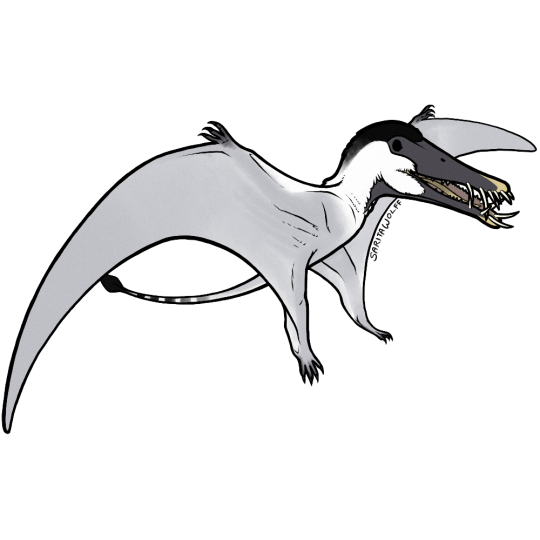
#Archovember Day 13 - Dorygnathus banthensis
Dorygnathus banthensis was a rhamphorhynchid that lived in the Early Jurassic of Europe, also in the time of the early Tethys Sea taking up most of the continent. (I did not realize I had put so many of these Jurassic archosaurs this close together when I made this list! We’ll be getting something from the Cretaceous tomorrow, don’t worry.) Like other rhamphorhynchids, it had a short neck, a long tail, and large interlocking fangs for catching and gripping wriggling fish. Wear on the teeth of some specimens suggest that they may have also fed on hard-shelled prey like mollusks and crustaceans. One specimen also contains preserved hairs, further evidence of pycnofibers or feathers in all pterosaurs.
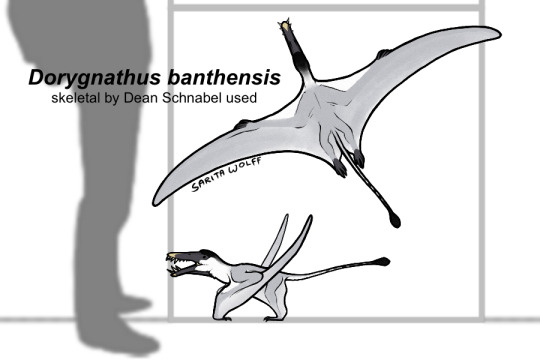
Dorygnathus was more common in its environment than its contemporary Campylognathoides, and both have been found in marine deposits suggesting they regularly traveled over open sea. Dorygnathus would have lived alongside our previously visited Macrospondylus bollensis as well as other teleosauroids like Mystriosaurus, Pelagosaurus, and Platysuchus. It would have come across sauropods like Ohmdenosaurus, and flown over the variety of Early Jurassic ocean life like icthyosaurs, small plesiosaurs, early sharks, ammonites, and much more.
#my art#SaritaDrawsPalaeo#Dorygnathus banthensis#Dorygnathus#Rhamphorhynchid#pterosaurs#archosaurs#archosauromorphs#Archovember#Archovember2023
24 notes
·
View notes
Text
Turnersuchus: First of the Sea Crocs
A big find for crocodile finds was revealed two days ago. Turnersuchus hingleyae (Hingley's and Turner's crocodile) is the oldest described and basalmost thalattosuchian described so far and is of great importance to slowly figuring out where thalattosuchians come from.
But lets start with a brief introduction to thalattosuchians. As the name already suggests, thalattosuchians are primarily known to have been marine animals (tho exceptions are known). thalattosuchians can broadly be split into two groups. The teleosauroids, which look somewhat similar to what one might call a normal crocodile, and the metriorhynchoids, which especially in the derived members could aptly be described as crocodile mermaids. Below an example of each, on the left Macrospondylus by Nikolay Zverkov and on the right a generalized metriorhynchid by Gabriel Ugueto.

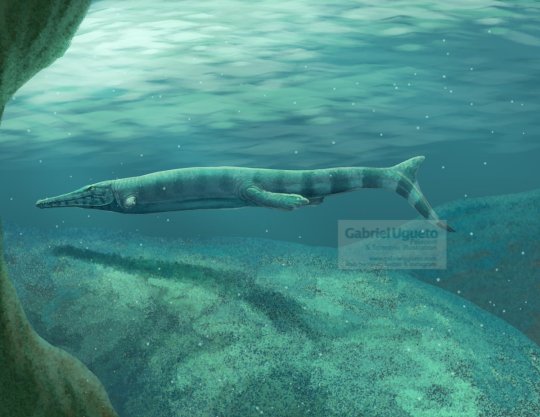
Thalattosuchians such as these two groups, which are sister clades and not successive lineages (so they co-occured rather than one having evolved from the other), were incredibly successful during the Jurassic, evolving enormous forms such as Plesiosuchus, Dakosaurus and Machimosaurus. Their wild success held on throughout the Jurassic until they eventually went extinct in the early Cretaceous. But despite how common and whidespread they are, we don't actually have much of a clue where they come from. Thalattosuchians just kinda appear during the Toarcian and are already found across multiple continents with both groups established. To complicate matters, their position among crocodiles is also rather shaky. Three main hypothesis exist. One is that they are a sister group to crocodyliforms (Protosuchians, Notosuchians and Neosuchians), that they are basal mesoeucrocodylians or that they are Neosuchians related to Pholidosaurids (like Sarcosuchus) and Dyrosaurs.
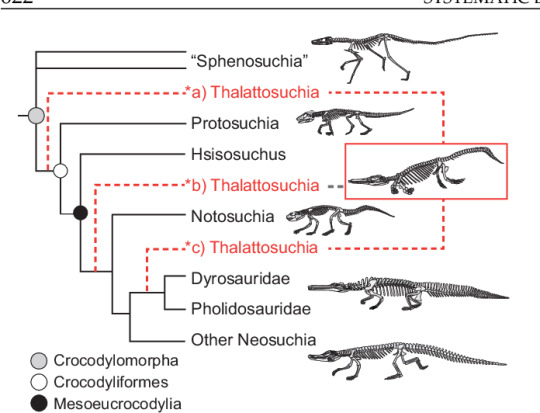
This is where Turnersuchus comes in. Discovered in the Charmouth Mudstone Formation of Dorset, England, this genus is known from the skeletal material belonging to the back of the head, mandible, parts of the forearms and shoulder girdle as well as neck, body and tail vertebrae all preserved in five blocks and a few isolated pieces of bone. From that we can already see general similarities to derived thalattosuchians and basic traits like narrow jaws and reduced forelimbs (tho not nearly as extreme as in metriorhynchids).
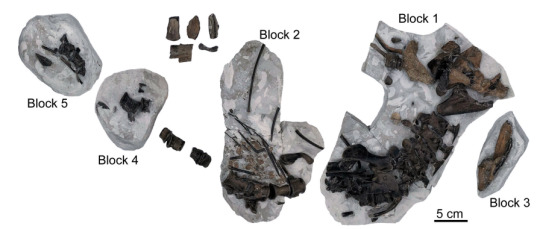
The first significant part about this discovery is its age. Turnersuchus is from the Pliensbachian stage of the Jurassic, so it predates any previously diagnostic thalattosuchians. Secondly is its position. As I said above, thalattosuchians are divided into teleosauroids and metriorhynchoids. But Turnersuchus is neither, with both phylogenetic analysis finding it to fall outside of these groups. Now in fairness this is not rock solid, as there is only a single trait excluding it from the derived groups in either analysis, so future works might shake things up. But as things are right now, it's the oldest named and basalmost member of the entire clade. On a sidenote at least the oldest part is bound to change, as the paper mentions a Moroccon teleosauroid currently in press that is even older.
All of this allows for two things. For one, by comparing Turnersuchus with the basal members of both teleosauroids and metriorhynchoids scientists were able to gather a list of traits that appear to be ancestral to the group. In addition, Turnersuchus also preserves some features that separate it from all other thalattosuchians that are also indicative of being an early member. Just as one example a specific part of the basioccipital thats associated with long skulls is poorly developed, which means that while slender the jaws weren't as long as in some later thalattosuchians. A Bayesian analysis was also conducted in an attempt to nail down when thalattosuchians evolved. Now depending on which phylogeny is used (one with thalattosuchians as non-crocodyliforms and another with them as mesoeucrocodylians) you get different times. The former would place their origin in the Norian stage of the Triassic, the later in the Sinemurian stage of the Jurassic. In light of the Moroccon material alluded to by the paper, it would appear that they likely split from other crocodylomorphs sometime in the late Triassic.
And finally to wrap this up let me share the press release artwork to finally give a face to all this information. Now if you've read my post about fossil crocs of 2022 you might already recognize the artist, as she's been on a real streak with illustrating fossil crocs. If you don't know her, I highly recommend checking out her work. I'm of course talking about Júlia d'Oliveira.

And yes, of course I got the Wikipedia page for it ready. Tho with work getting in the way when it was published I almost feared I'd be unable to get to it first.
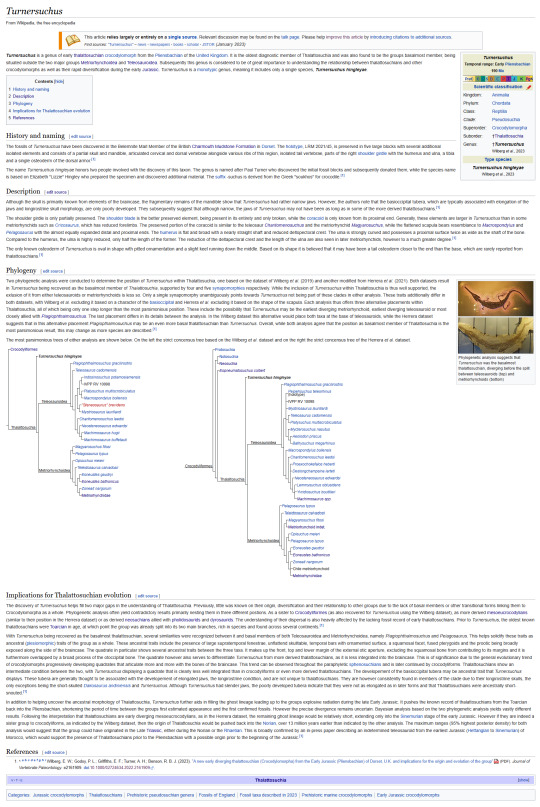
#turnersuchus#thalattosuchia#metriorhynchidae#teleosauridae#jurassic#paleontology#palaeblr#crocodylomorph#croc#pseudosuchian#marine reptile#long post#Wikipedia#paleontology news#crocodile
117 notes
·
View notes
Text
L'antico albero genealogico dei coccodrilli rivela colpi di scena inaspettati
L’antico albero genealogico dei coccodrilli rivela colpi di scena inaspettati


L’impressione artistica di Macrospondylus – un gruppo fossile estinto di teleosauridi.
Gli scienziati che sondano l’oscuro passato di un gruppo di coccodrilli preistorici hanno scoperto una poro della verità senza tempo sull’albero genealogico di chiunque, e qualcosa di sorprendente emergerà.
Nonostante 300 anni di ricerche, e una recente rinascita nello studio della loro composizione…
View On WordPress
0 notes